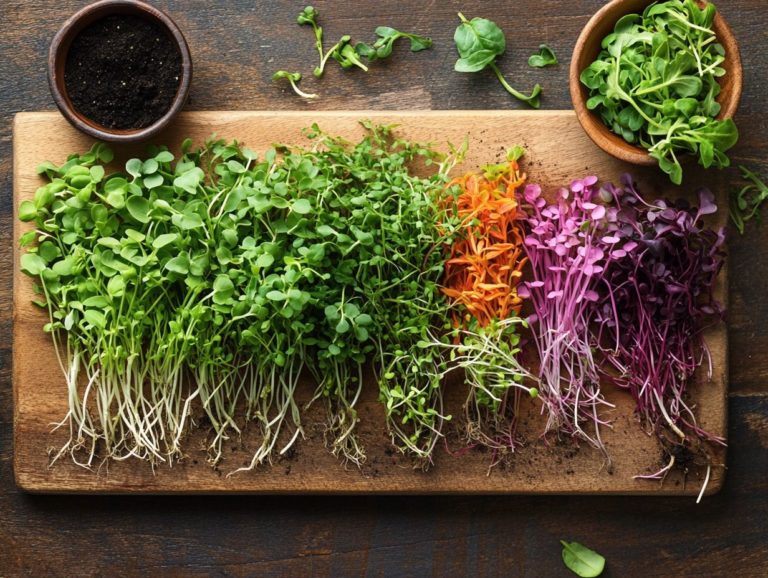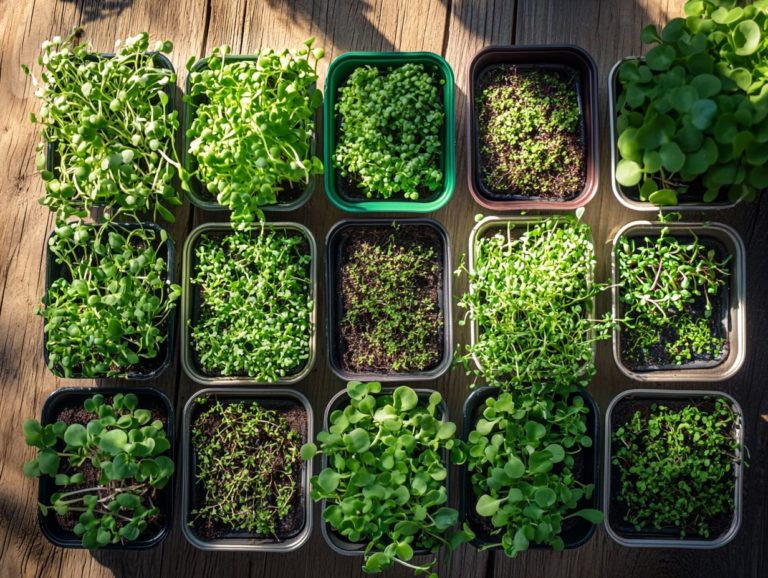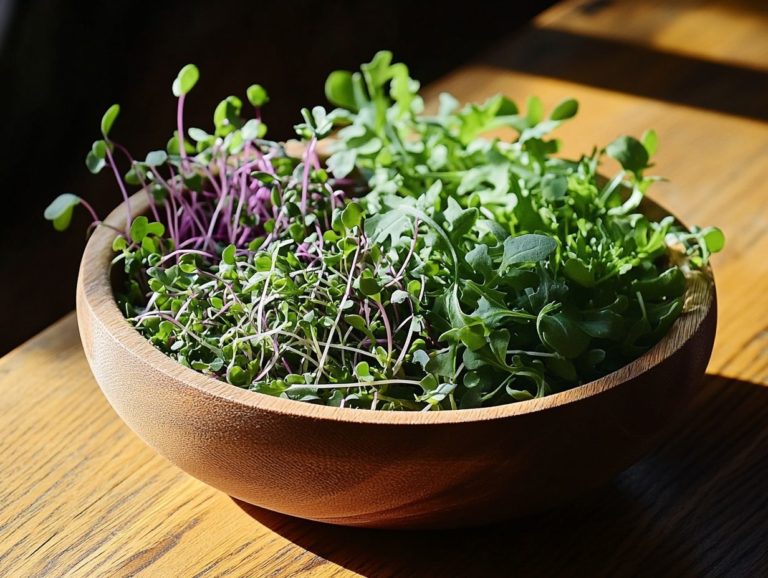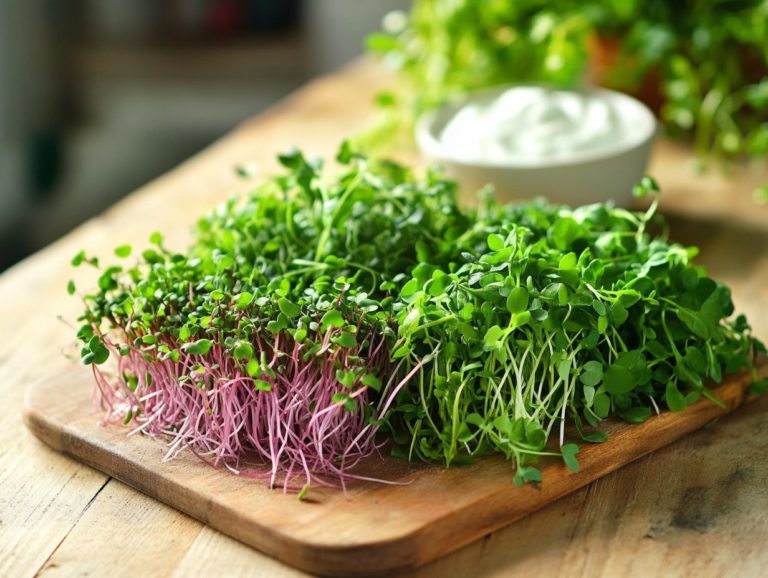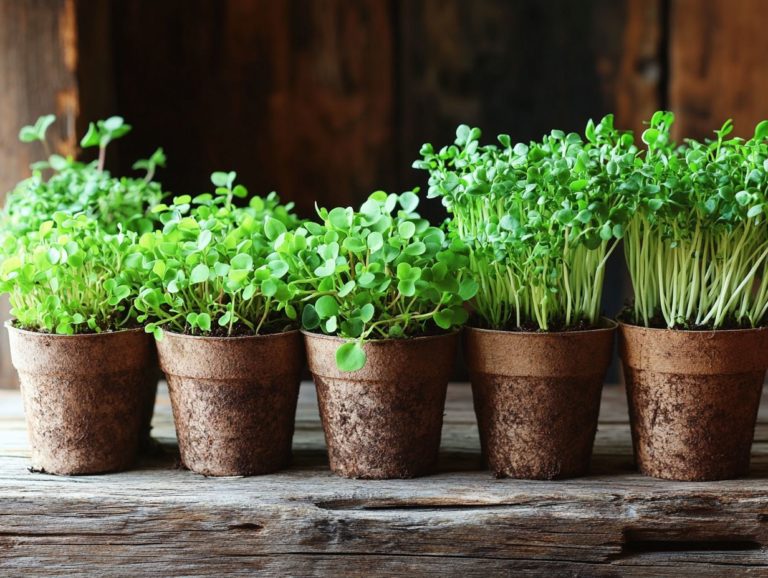5 Microgreens to Revitalize Your Diet
Microgreens are small yet mighty greens brimming with nutrients, delivering both health benefits and a burst of flavor that can transform any dish.
Let s dive into the world of microgreens and discover why they re a must-have in your diet! This piece highlights five standout microgreen varieties broccoli, radish, sunflower, pea, and the increasingly popular arugula microgreens that you don t want to miss.
You ll find essential tips on cultivating your own, covering everything from the ideal growing conditions to managing common pests.
Uncover how these vibrant greens, rich in vitamins and minerals, can elevate your meals and enhance your well-being, making each bite not just delicious but also nourishing.
Contents
- Key Takeaways:
- 1. What Are Microgreens?
- 2. Why Should You Incorporate Microgreens into Your Diet?
- 3. Broccoli Microgreens
- 4. Radish Microgreens
- 5. Sunflower Microgreens
- 6. Pea Microgreens
- 7. Beet Microgreens
- 8. Cilantro Microgreens
- 9. Basil Microgreens
- 10. Wheatgrass Microgreens
- How to Grow Your Own Microgreens
- Frequently Asked Questions
Key Takeaways:
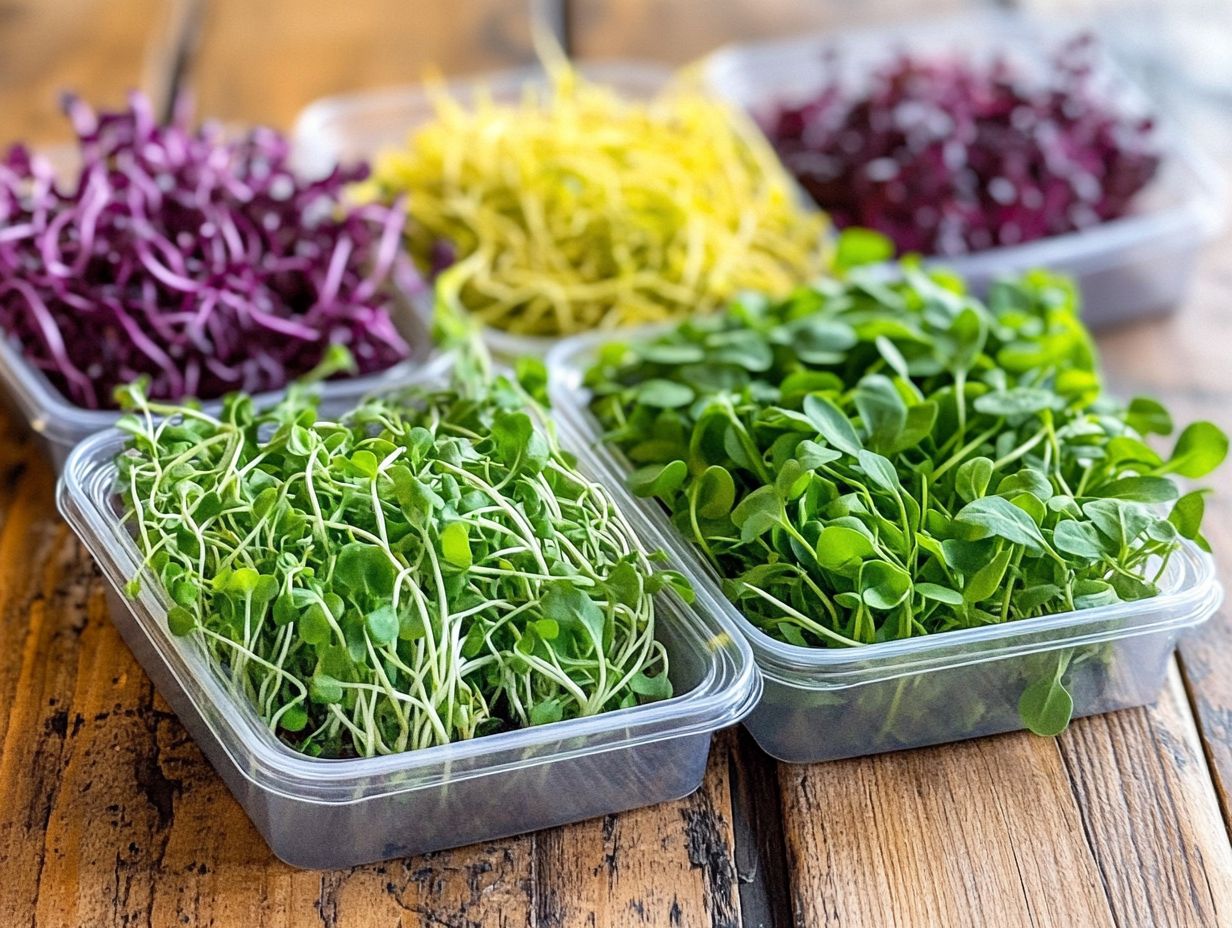
- Add color, flavor, and nutrition to your meals with microgreens small but mighty plants packed with nutrients. Incorporate popular varieties like basil and arugula for a unique nutritional punch.
- Incorporate nutrient-dense microgreens into your diet to boost your immune system, improve digestion, and increase energy levels through their rich antioxidant content.
- Grow your own microgreens at home using simple and eco-friendly methods, enjoying fresh greens within 1-2 weeks a perfect fit for urban gardening enthusiasts.
1. What Are Microgreens?
Microgreens are the young, edible greens you can easily harvest right after the first true leaves have emerged. They stand out for their vibrant colors, delicate flavors, and exceptional nutrient density, making them a favorite among health-conscious individuals eager to elevate their plant-based diets.
You’ll find various types, including arugula, basil, pea shoots, radish, and broccoli. Each showcases unique tastes and nutritional benefits. For instance, arugula delivers a peppery zing, while basil offers a fragrant sweetness, and both are loaded with essential vitamins like A, C, and K.
The growing techniques are remarkably versatile, ranging from soil cultivation to hydroponics growing plants in water without soil allowing even the most novice gardener to thrive. These greens flourish in compact spaces, reflecting a growing trend toward sustainable practices and fitting perfectly with the modern focus on nutritious, fresh food.
In home gardening, their ease of cultivation makes them an ideal choice, enabling you to enjoy a steady supply of these nutrient-packed crops right at your fingertips.
2. Why Should You Incorporate Microgreens into Your Diet?
Incorporating microgreens into your diet opens the door to a wealth of health benefits. These tiny greens are incredibly nutrient-dense, brimming with vitamins and minerals like vitamin C, iron, and copper, all of which can elevate your energy levels and enhance the effectiveness of your immune system.
These tiny greens also promote gut health, thanks to their impressive fiber content. Rich in antioxidants like glutathione and polyphenols, microgreens help combat oxidative stress and inflammation, both of which are often linked to chronic diseases.
Integrating these greens into your daily meals is a breeze. They can easily be tossed into salads, blended into smoothies, or used as garnishes for a variety of dishes. Not only do they provide a burst of flavor, but they also deliver a substantial nutritional boost without overwhelming your palate.
3. Broccoli Microgreens
Broccoli microgreens stand as some of the most nutrient-dense foods available, brimming with essential vitamins like vitamin C and vital minerals such as calcium and iron. Plus, these tiny greens are packed with powerful antioxidants that contribute to a multitude of health benefits.
Rich in sulforaphane, they have demonstrated the ability to combat cancer by targeting and inhibiting the growth of cancer cells, making them an impressive addition to any health-conscious diet. Their delicate flavor and vibrant green hue make for effortless incorporation into a variety of dishes, enhancing both taste and nutrition.
Whether you choose to toss them into salads for a delightful crunch, layer them in sandwiches for added flavor, or use them as a garnish to elevate soups and entrees, broccoli microgreens offer a versatile and tasteful way to enhance your nutrition while savoring your meals.
4. Radish Microgreens
Radish microgreens are loved for their spicy flavor and striking appearance. They are a fashionable choice in the culinary world. Whether you want to add a zesty kick to salads or elevate gourmet dishes with a vibrant garnish, these little greens deliver flair and health benefits.
Their peppery taste transforms everything from sandwiches to soups, providing an unexpected burst of flavor that delights the palate. Not only do they enhance the visual appeal of your plate, but they also offer a nutritional boost, packed with antioxidants that support your overall health.
With high fiber content aiding digestion, incorporating radish microgreens into your diet is a wise choice, especially as they promote gut health. Their versatility shines through, as they can be blended into smoothies or serve as the base for a lively pesto. For those looking to enhance their culinary creations, consider exploring unique microgreens to elevate your dishes.
5. Sunflower Microgreens
Sunflower microgreens are not just a feast for the eyes; they are a great source of nutrients. Packed with omega-3 fatty acids (a type of healthy fat), vitamin E, and essential minerals, these tiny greens bring many benefits.
These microgreens taste delicious, featuring a subtle nuttiness that elevates an array of dishes. Their high omega-3 content promotes heart health, while vitamin E acts as a strong antioxidant, protecting your body’s cells. Additionally, exploring microgreen varieties that boost your immune system can further enhance your well-being.
Incorporating sunflower microgreens into your salads, sandwiches, or smoothies can easily enhance the nutritional value of your meals. They also serve beautifully as a garnish for soups or can be blended into pestos for a unique twist.
Adding sunflower microgreens to your meals not only boosts healthfulness but also introduces a delightful texture and taste that will impress your palate.
6. Pea Microgreens
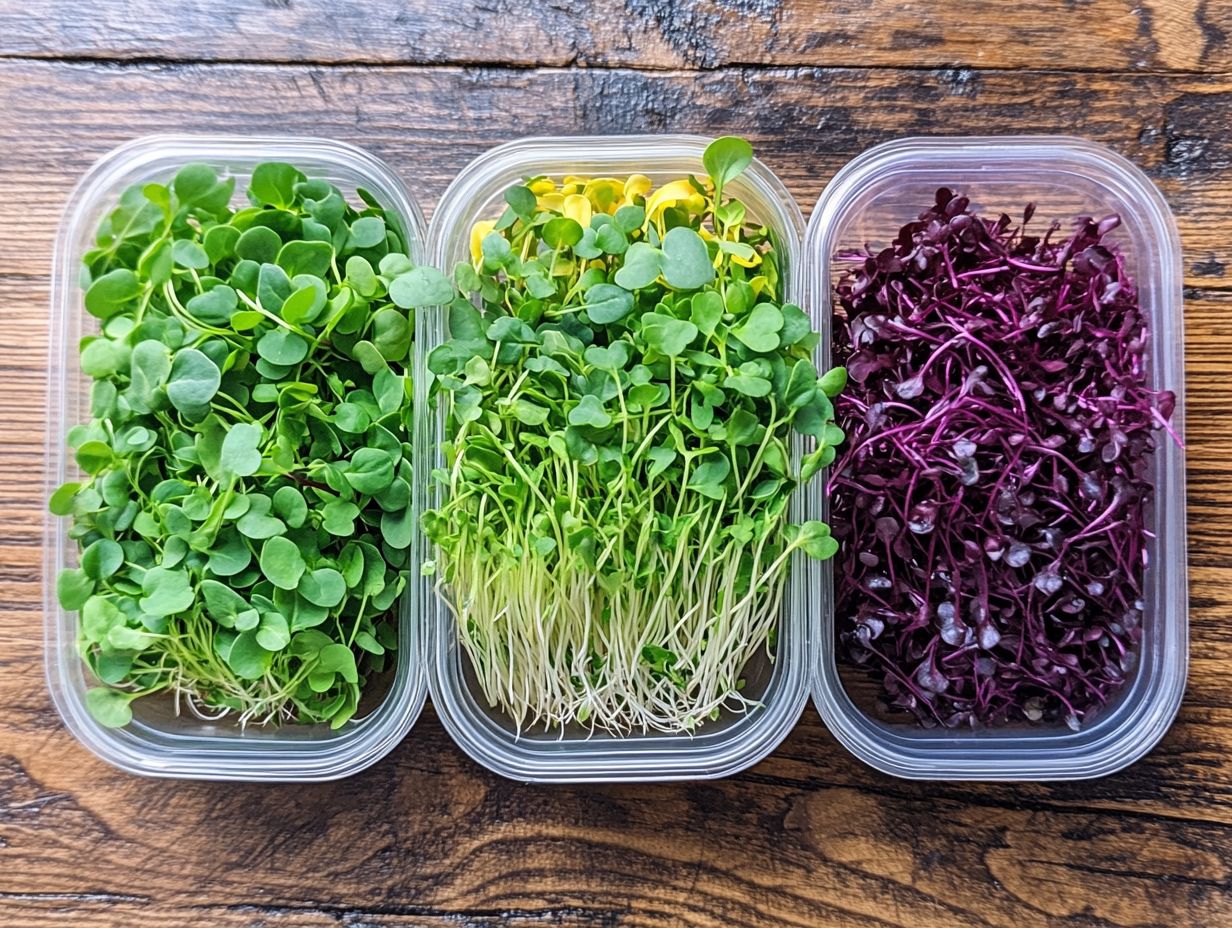
Pea microgreens are a culinary gem, celebrated for their sweet flavor and delicate texture. They are a great addition to salads and various dishes while delivering a bounty of vitamins, minerals, and fiber.
These tiny powerhouses are rich in vitamins A, C, and K, all essential for supporting immune function and promoting bone health. Their high fiber content is beneficial for gut health, aiding digestion and nurturing healthy gut bacteria.
If you want to enhance your meals, consider adding pea microgreens to wraps or smoothies, or use them as a garnish for soups. Stirring them into scrambled eggs or blending them into pesto can elevate everyday dishes, showing that healthy eating can be enjoyable. For a delicious twist, explore 5 nutritious microgreen varieties for smoothies.
7. Beet Microgreens
Beet microgreens are a feast for the eyes with their vibrant hues and a great source of nutrients. Packed with antioxidants and vitamins, they elevate the flavor diversity in your culinary creations.
These tiny greens offer a subtle earthy sweetness, making them an exquisite addition to a range of dishes, from fresh salads to hearty sandwiches. For salad lovers, exploring must-try microgreen varieties can enhance your meals. Rich in essential vitamins A, C, and K, they also provide vital minerals like iron and calcium, making them a nutritional powerhouse.
Whether you re a professional chef or a home cook, you’ll appreciate their versatility. Use them as a garnish, layer them into wraps or tacos, or blend them into smoothies for an extra health boost.
8. Cilantro Microgreens
Cilantro microgreens deliver a vibrant burst of fresh flavor that elevates your dishes. They are a favored addition across diverse cuisines and a staple in many households.
Not only do they offer a delightful taste experience, but they are also rich in antioxidants that boost your health!
These lively greens enhance the taste of soups, salads, and tacos, bringing a unique aromatic quality that can transform any meal into a culinary masterpiece. Rich in vitamins A, C, and K, cilantro microgreens support skin health, bolster immunity, and strengthen bones.
Their delicate hint of citrusy zest brightens even the most uninspired recipes, inviting you to play with textures and flavors without overwhelming your palate.
By incorporating cilantro microgreens into your daily meals, you can effortlessly blend nutrition with exquisite taste, making each bite delicious and nutritious.
9. Basil Microgreens
Basil microgreens are a delightful and nutrient-packed enhancement for any dish. They are celebrated for their aromatic qualities and packed with vitamins and antioxidants that support a healthy lifestyle.
These tiny greens are packed with vital nutrients that can elevate your health! They include vitamins A, C, and K, as well as minerals like calcium and iron. Their vibrant green hue and distinct flavor make them ideal for a variety of culinary creations, especially when you consider the top 5 microgreens for smoothies.
Whether you sprinkle them atop a fresh Caprese salad, blend them into rich pesto, or use them to garnish soups and pasta, basil microgreens enhance the visual allure of your meals and infuse them with a burst of flavor.
Their versatility allows you to seamlessly integrate them into both savory and sweet dishes, making these microgreens a charming addition to any kitchen!
10. Wheatgrass Microgreens
Wheatgrass microgreens are gems in the health world, known for their ability to help cleanse the body and packed with essential vitamins and antioxidants that bolster your immune function.
These vibrant greens are full of chlorophyll, a powerful compound that helps flush out toxins and neutralize acidic substances. You can easily enjoy wheatgrass in refreshing juices or blend it into nutrient-rich smoothies.
These greens also add a unique flavor, and their robust nutritional profile elevates the vitality of any drink. For maximum benefits, eat them fresh!
This way, you ensure that those vital nutrients are preserved, paving the path toward improved health and increased energy levels.
How to Grow Your Own Microgreens
Growing your own microgreens is not just an eco-friendly choice; it s a rewarding journey that lets you enjoy a delightful array of nutritious greens right from the comfort of your home.
These tiny powerhouses require minimal space and adapt well to various growing conditions, making them ideal for urban gardening.
Let’s dive into how to grow your own microgreens!
You can cultivate them using different techniques, particularly soil and hydroponic methods. Soil-based growing provides a traditional experience with rich nutrient retention, while hydroponic systems yield faster growth rates and simpler maintenance.
Choosing organic seeds is essential for the purity and health of the microgreens you re cultivating. Start with a shallow tray, wet the soil well, and evenly scatter the seeds for optimal germination.
After planting, nurture them with adequate light and moisture. In just a few weeks, you can harvest your greens when they reach about 1-3 inches in height, ready to elevate your meals with their vibrant flavors.
Start growing today and enjoy the fruits of your labor!
What Are the Best Growing Conditions for Microgreens?
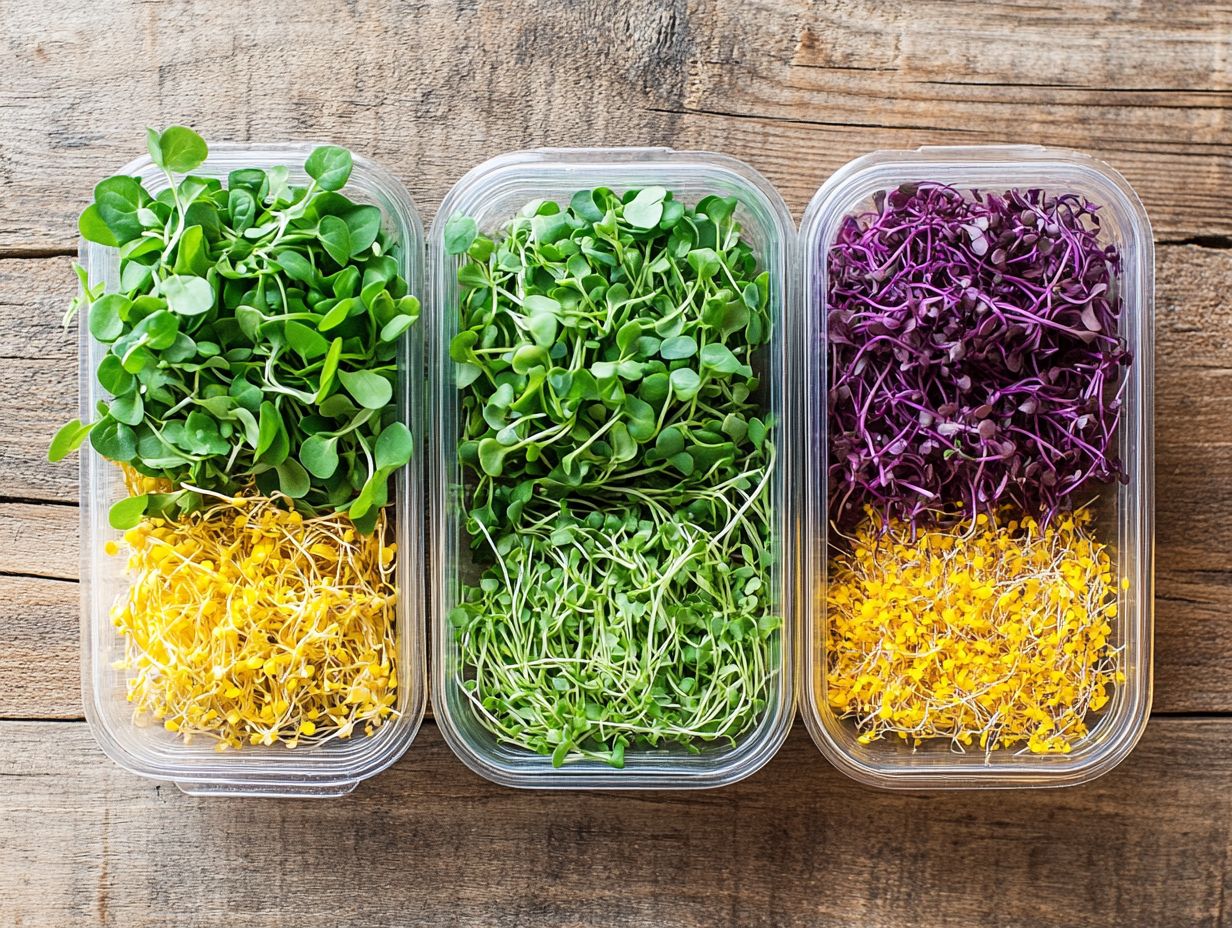
Microgreens thrive in the best growing conditions. They need light, moisture, and warmth to flourish. This harmonious environment allows them to develop into nutrient-rich greens brimming with flavor and health benefits.
To create these ideal conditions, strike the right balance of light aim for about 12 to 16 hours per day using fluorescent or LED grow lights for the best results. Moisture is equally important; keep the soil consistently damp but not waterlogged. A daily misting can help you achieve that perfect balance.
Each variety has its own temperature preferences, typically ranging from 60 to 75 F. By understanding these specific needs, you can fine-tune your growing environment for various microgreens, ensuring a robust and flavorful harvest every time.
What Are the Different Methods for Growing Microgreens?
You can choose between soil or hydroponics when growing microgreens. Both methods offer unique benefits.
When you opt for soil-based growing, you’ll typically use seed-starting mixes or organic soil. This provides natural nutrients that help your seedlings thrive. This method fosters healthy root development and enhances the flavor profile of your microgreens, delivering satisfying taste in every bite.
If you choose hydroponic systems, you’ll rely on nutrient-rich water solutions that promote faster growth while minimizing disease risks. For soil cultivation, your equipment can range from simple seed trays and pots to more sophisticated setups with humidity domes. Hydroponics may require specific containers, grow lights, and pumps to circulate the nutrient solution effectively.
Ultimately, each method caters to different preferences and available spaces, making them appealing to both novice and seasoned gardeners.
How Long Does It Take for Microgreens to Grow?
The growth time for microgreens varies by variety, but most can be harvested in just 7 to 21 days. Quick and satisfying!
If you opt for faster-growing varieties like radish and broccoli, you’ll enjoy your harvest in as little as 7 to 10 days. On the other hand, sunflower or pea shoots may take closer to two weeks or more to reach their peak.
Several environmental factors influence how swiftly your microgreens mature. Providing adequate light especially natural sunlight or grow lights can significantly speed up growth. Maintaining an optimal temperature, ideally between 60 and 75 F, also plays a crucial role in enhancing growth rates.
By understanding these elements, you can optimize your microgreen cultivation and relish the fruits of your labor in no time.
What Are the Common Pests and Diseases That Affect Microgreens?
Microgreens face pests and diseases, but you can protect your crops with organic methods.
Familiarizing yourself with the most common culprits is a crucial first step. Aphids, spider mites, and damping-off disease frequently disrupt microgreen cultivation.
Adopting a comprehensive approach like rotating crop varieties, maintaining optimal moisture levels, and utilizing neem oil or insecticidal soap can significantly bolster your defenses against these invaders.
You can introduce beneficial insects like ladybugs to help establish a natural balance in your growing environment. By integrating these eco-friendly strategies, you can cultivate a vibrant microgreen garden, free from harsh chemicals and brimming with life.
How Can You Incorporate Microgreens into Your Meals?
Incorporating microgreens into your meals is a simple yet elegant way to elevate both flavor and nutrition.
You can sprinkle them atop salads, use them as garnishes for entrees, or blend them into smoothies. Their versatility in culinary applications is undeniable.
These tiny greens are not just packed with nutrients; they infuse vibrant flavors and textures into a myriad of dishes. Imagine enhancing a simple omelet with a sprinkle of microgreens right before serving for that fresh pop. For more ideas on how to elevate your meals, consider How to Incorporate Microgreens into Your Diet. Adding them to grain bowls pairs well with roasted vegetables and proteins, making your meal visually stunning and delicious.
Try making a microgreen pesto for an exciting twist on your pasta. It combines traditional flavors with a fresh touch. Experiment with different varieties like radish and basil microgreens! You ll discover endless ways to enhance your meals.
Frequently Asked Questions
What are microgreens?
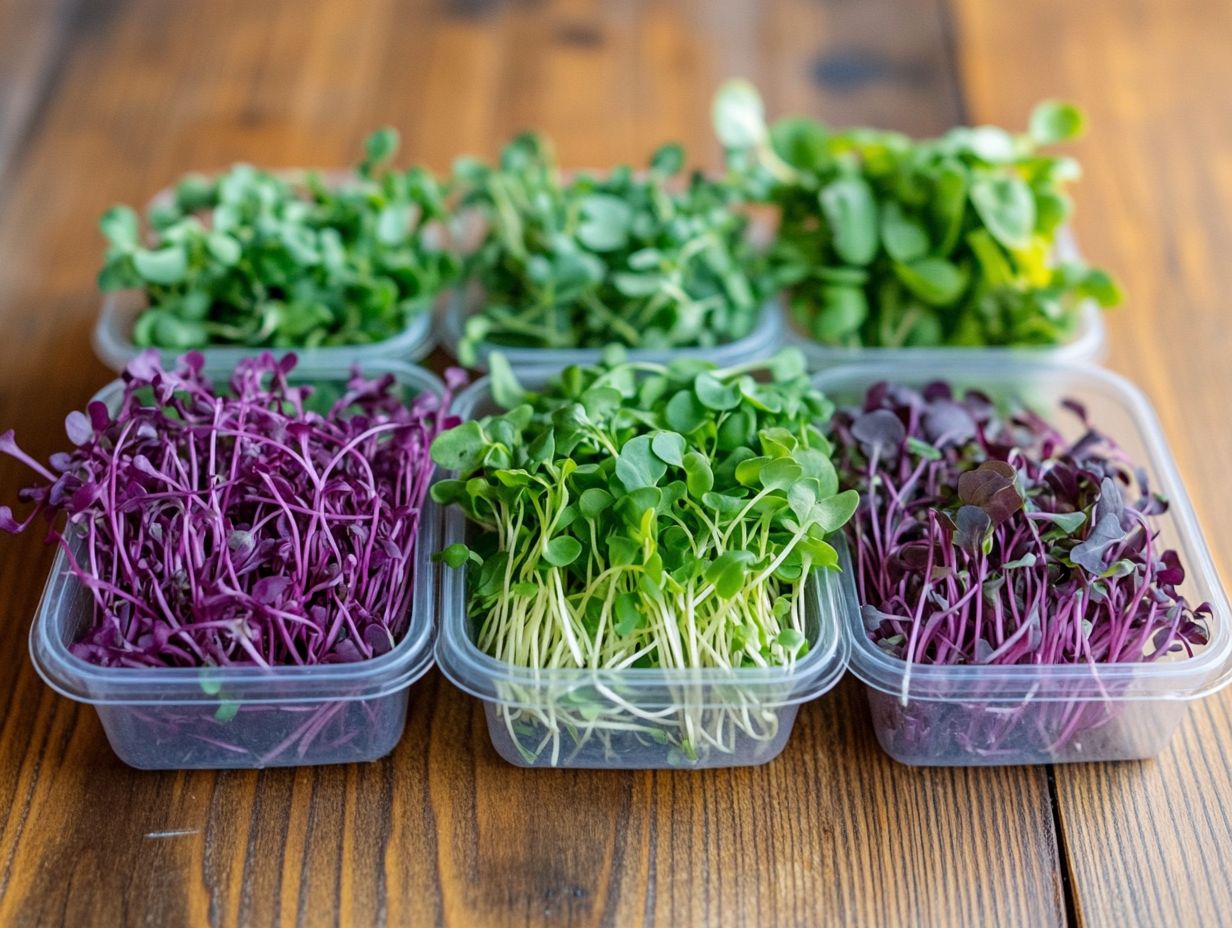
What are some popular types of microgreens?
Some of the most popular types of microgreens include broccoli, kale, radish, pea shoots, and sunflower shoots. Other common varieties include cilantro, arugula, and beet greens.
Why should I incorporate microgreens into my diet?
Microgreens are loaded with essential vitamins and minerals. They make every meal healthier and more colorful!
How can microgreens revitalize my diet?
Microgreens are an easy and convenient way to add a variety of nutrients to your diet. They can help boost your immune system, improve digestion, and promote overall health and wellness.
Can I grow my own microgreens at home?
Yes, you can easily grow your own microgreens at home with minimal space and equipment. All you need is a shallow container, some soil, and seeds. They can be grown indoors or outdoors, and are ready to harvest in just a few weeks.
Start adding microgreens to your meals today! Your taste buds and body will thank you!

